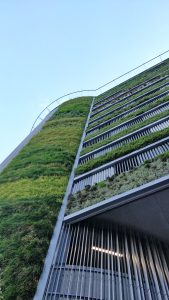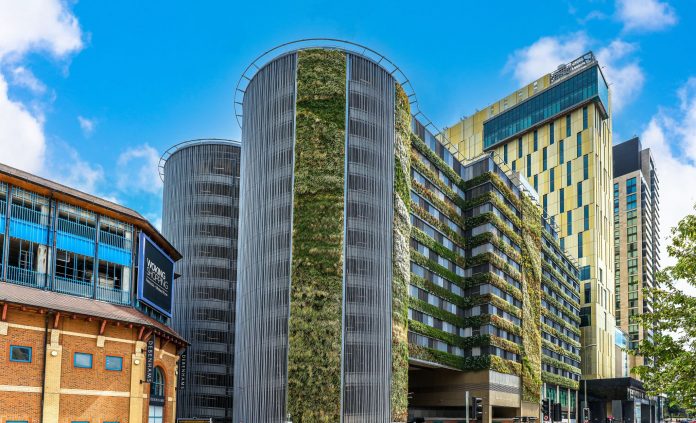Steve McIntyre, principal urban environment consultant at biophilic infrastructure specialists ANS Global, takes the perplexity out of new biodiversity net gain requirements with green solutions, such as living walls
In November 2023, the Environment Act will make it mandatory that any new development in England must demonstrate a minimum of 10% biodiversity net gain (BNG). This requires development to improve the land, leaving it in a better and more biodiverse state than before. Yet for many infrastructure projects, BNG implementation will be a significant challenge, especially for urban sites where space is limited.
For many urban proposals, the key to securing future developments will lie in utilising what was once seen as wasted space. With the ability to even wrap multi-storey buildings in a rich green oasis, living walls can encase developments to support in the biodiversity quota needed, keeping premium development space free for construction while meeting, or even exceeding, BNG compliance.
Many forward-thinking designs and planning applications are already harnessing the power of living walls to gain the approval of local authorities, with these vertical gardens offering much more than just aesthetic appeal. They boast abundant long-term benefits for both people and planet. A strategic option for those looking to gain BNG approval, living walls have a greater ability to support rich biodiversity compared with other design and infrastructure choices.
 Living walls for Victoria Way carpark
Living walls for Victoria Way carpark
Looking to a recent ANS Global project for Victoria Way Carpark, this multi-storey carpark became the unlikely home of an abundance of wildlife, including multiple bird nests, thanks to its substantial living wall design creating the ideal habitat. Part of the huge regeneration project in Woking, created in collaboration with Woking Borough Council and Moyallen Group, the key project driver for this development was biodiversity.
Such success is all down to the initial implementation of the living walls; introducing already established plants, as well as the necessary inclusion of soil-based systems found in advanced living wall designs, which together provide opportunity for these vertical installations to thrive long-term and form vital new habitats in the most unlikely of places.
Living wall design for Dukes Court
Demonstrating the BNG qualities possible with a living wall, the planting scheme for another ANS Global project, Dukes Court, consisted of plant species that provide sources of nectar throughout the seasons. Abuzz with pollinators throughout the year, this extensive living wall design offers an alternative ecological habitat for a variety of wildlife to flourish. It even includes bird boxes, which have been extremely successful.
In order to deliver projects like Dukes Court and Victoria Way Carpark, it is crucial that the plant species are not invasive. Both native and non-native species provide benefits to local ecology, but when looking at non-native variants, it is important to ensure they do not have invasive characteristics.
Getting the combination right helps local wildlife and pollinators to thrive and, in turn, ensures the development adheres to BNG requirements. Those that fail BNG compliance have typically been planted with ornamental varieties that deliver low value in terms of biodiversity, such as poor conditions for bees and burrowing insects. With this in mind, it is best to work with a living wall specialist who can advise on BNG, offering expertise on horticulture and wildlife as well as design and construction.
Part of Dukes Court’s success can also be attributed to ANS Global’s soil system, which provides the right conditions for the plant species to prosper long-term. Soil-based systems are vital to ensuring a “lifetime” living wall, as they provide longevity to the installation; a system which enables planting to be maintained for years to come, therefore ensuring that habitats can be maintained. This makes living walls an integral factor in demonstrating BNG compliance, as they can effectively secure habitats for the Environment Act’s outlined minimum time period of at least 30 years.
What are the benefits of living walls?
One of the key drivers for the introduction of BNG is to address the climate emergency. Another key benefit of living walls is the ability of the system to combat carbon, another reason why the future of infrastructure should be looking to utilise living walls as part of development. It is a simple but exceptionally effective way to reduce the carbon footprint of a build and achieve carbon neutral status.
As an example, Victoria Way Carpark has a 1,700sq m living wall, which is capable of extracting 2,210kg of carbon each year, making it not only of immediate benefit to the local environment but also long-term for the planet. What’s more, its strategic vertical design makes it the equivalent of 85 fully established trees in terms of carbon sequestered. Evidencing how living walls can work ticks the boxes of the BNG checklist without sacrificing prime construction space – all while driving tangible, positive benefits.
Living walls have also been proven to significantly improve air quality, another important factor set out in the aims of BNG. Looking to Dukes Court as an example, the 460sq m living wall produces 782kg of O2 and traps 59.8kg of harmful dust per year.
Highly impressive results that positively impact the health of the surrounding community, this particular living wall has been strategically planted with a large number of species that offer significant air purification properties. It delivers a healthier atmosphere in the immediate area, as well as creating a building which will reap an array BNG benefits for years to come.
From air quality and combatting carbon, to creating thriving “forever” habitats, living walls are the answer to not only gaining BNG compliance but also in creating a greener, healthier future for the construction industry.
To gain further insight, ANS has created two best practice guides to help you successfully deliver projects in accordance with BNG, these have been created in collaboration with AECOM, and approved by BRE, Defra, Natural England and UKHab. The guides – Using Urban Green Infrastructure to Achieve Biodiversity Net Gain and Urban Green Infrastructure Technical Guide – are available to download for free.
Steve McIntyre
Principal urban environment consultant
Tel: +44 (0)1243 545818














